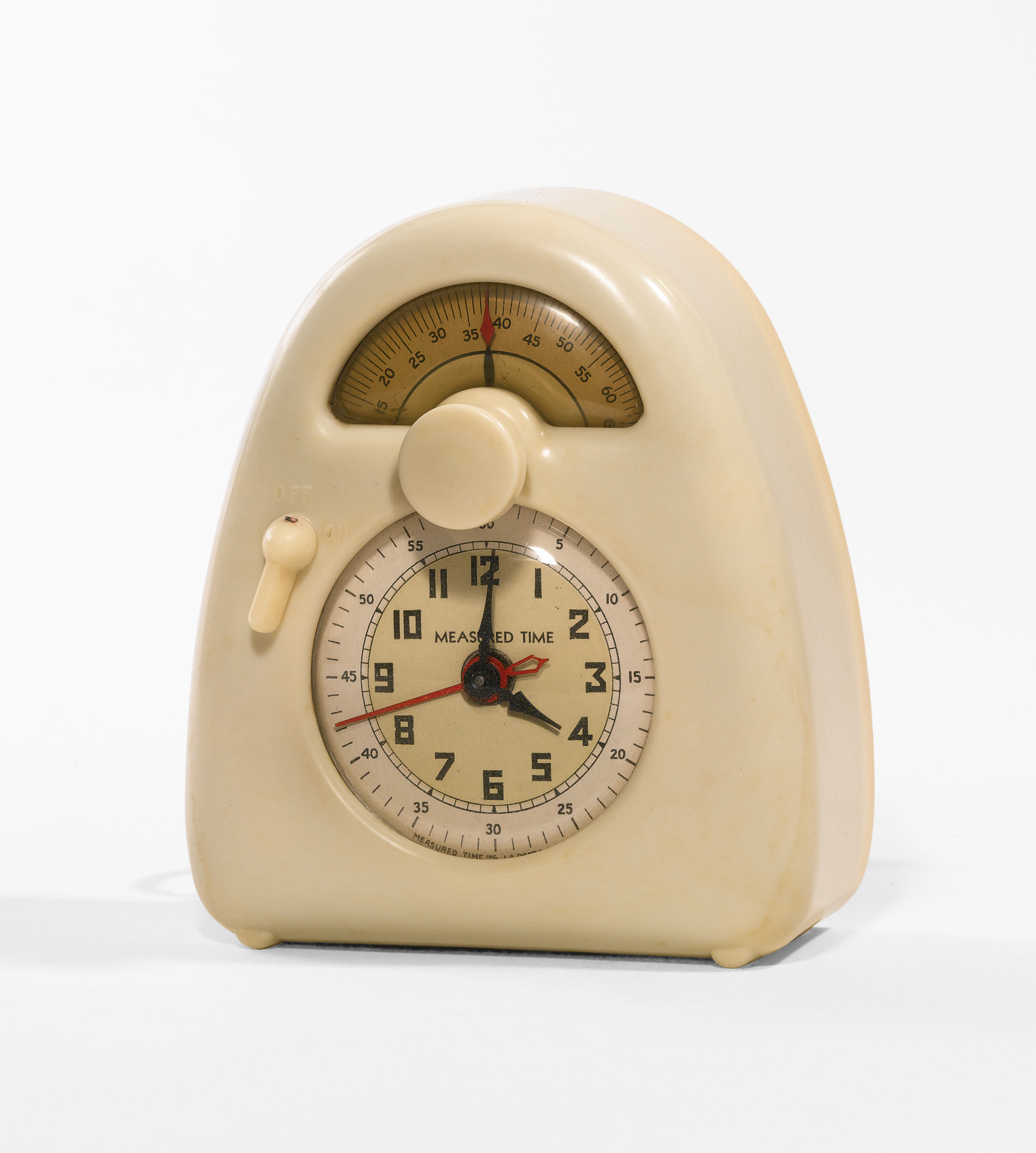Clocks, calculators, measuring tapes, and scales—tools for measurement and calculation have long been important for people to accomplish tasks at work, school, and home. A new display in the 20th- and 21st-Century Design Galleries considers the role designers played in shaping such devices in the twentieth century, with examples from the 1920s-1980s. On one hand, these objects demonstrate how many designers aimed to make tools that are simple to use and easy to read, such as the streamlined kitchen clock and timer that Isamu Noguchi designed for Measured Time, Inc. in the early 1930s. At the same time, these designs bring to light how measurement and calculation have been closely linked to the human body in the twentieth century, as this post explores.
Though the practice of timekeeping extends back thousands of years, new strategies of labor management emerged in the early twentieth century that placed particular emphasis on keeping track of time and bodies in tandem. In the United States, labor theorists Frederick Taylor and Frank and Lillian Gilbreth introduced and popularized methods of scientific management. In particular, they used time and motion studies to first evaluate workers’ behavior, and then modify it for maximum efficiency. [1] The Gilbreths developed the chronocyclograph, which used small electric lights attached to workers’ bodies to produce images of tasks being accomplished over time. The idea was that through such studies, inefficient ways of working could be identified and replaced with standard practices that would increase productivity at work and at home. [2]

In this period, standardization was seen not only as a means of modernizing production, but also consumption. In terms of measuring bodies, this relates especially to the rise of ready-made clothing and shoes. For instance, the foot care brand known today as Dr. Scholl’s, originally founded in 1906 in Chicago as the Scholl Manufacturing Company, contributed to the transition from custom-made shoes to off-the-shelf options through the invention of a patented measuring device, Dr. Scholl’s Automatic Shoe Sizer. [3] The tool, which features a surprisingly complex system of hidden mechanical components, helped salespeople to quickly identify which standard shoe size would provide the best fit—a practice that continues today.

In the mid-twentieth century, the field of ergonomics began to emerge in the United States as a means of creating products and workplaces better suited to the complexities of human bodies. Also referred to as the study of “human factors” or “human engineering” in its early years, ergonomics had roots in theories of scientific management. However, in addition to Taylor and the Gilbreths’ interest in training humans to work more efficiently, ergonomics also posed the question, “how can the machine be designed so that the man can operate it most efficiently?” [4]
American industrial designer Henry Dreyfuss was a leading voice in this endeavor. His 1955 book Designing for the People encouraged designers to take human bodies into greater account in their work. The book introduced drawings by Alvin R. Tilley of “Joe” and “Josephine,” whose proportions were meant to represent the typical American user. [5] In the following decades, Dreyfuss’ understanding of ergonomics evolved to account for a greater range of bodies. In 1974, his office produced Humanscale, a series of booklets accompanied by brightly colored plastic sleeves containing paper dials that could be rotated to reveal information on dimensions and capabilities of various types of people, including men and women; children, adults, and the elderly; and able-bodied and disabled individuals. This multiplicity is mirrored by the collaborative nature of the project itself; Humanscale was co-authored by designers Niels Diffrient, Alvin R. Tilley, Joan C. Bardagjy, and David Harman, and designed by 27-year-old graphic designer Valerie Pettis, who created the emblem for the 1975 International Women’s Year around the same time.

At first pass, tools like Humanscale, the Gilbreths’ chronocyclograph, and Dr. Scholl’s shoe sizer may seem specialized, even idiosyncratic. Yet when taken together, they reveal significant intersections between production, consumption, time, and bodies in histories of twentieth-century design. These and other tools for measurement and calculation can now be seen in the Museum’s 20th- and 21st-Century Design Galleries, and will remain on view at least through the end of 2019.
[1] See: Frederick Winslow Taylor, The Principles of Scientific Management (New York: Harper & Brothers Publishers, 1911); and Frank B. Gilbreth, Primer of Scientific Management (New York: D. Van Nostrand Company, 1912).
[2] Laurel D. Graham, “Domesticating Efficiency: Lillian Gilbreth’s Scientific Management of Homemakers, 1924-1930,” Signs 24, no. 3 (1999): 633-675.
[3] Penny Sparke, et. al., Industrial Design in the Modern Age (New York: Rizzoli Electa, 2018), 127.
[4] Leonard C. Mead and Joseph W. Wulfeck, “Human Engineering: The Study of the Human Factor in Machine Design,” Scientific Monthly 75, no. 6 (1952): 373.
[5] Ellen Lupton, Beautiful Users: Designing for People (New York: Princeton Architectural Press, 2014), 24.



